Nick Sly is an ornithologist, recently graduated from Cornell and cast into the real world. He is currently located in Venezuela, in his first field job out of school, helping a Cornell PhD student, Karl, with his dissertation on vocal communication in Green-rumped Parrotlets. This population of parrotlets is located on one of the many huge hatos (cattle ranches) in the Venezuelan llanos, a vast swath of flat flooded savannah in the central third of the country that drains into the Rio Orinoco. He has gifted us with this incredible insight into his work while on location…
13 September 2008
Hato Masaguaral
Guarico, Venezuela
The dawn sky breaks almost cloud free. Not good, I think – it will probably be another scorcher. My morning routine has already been simplified down to the essentials – roll out of bed and out from under the protective mosquito net, pull on dirty odorous field clothes, munch down a quick breakfast. Load up the gear – mini maglight in one breast pocket, field notebook and pencils in the other, big bottle of water, binoculars, camera. Lather on the SPF 50 sunblock and don my field hat. Empty out the rubber boots of any nighttime invaders before pulling them on. Backpack on, nest check clipboard attached, small folding chair over one shoulder, scope over the other shoulder.
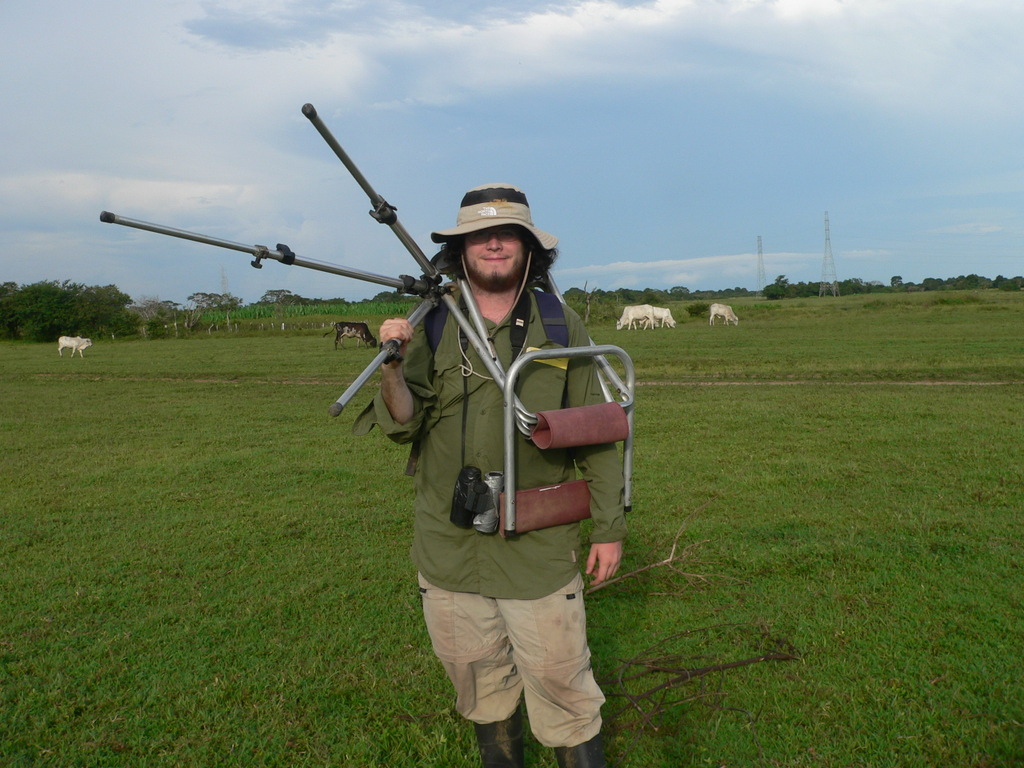
Hard at work in the land of cows and sun
Greeting me outside the Casa is the dawn chorus. At times it seems the chorus around the cluster of ranch buildings at Hato Masaguaral is 95% doves. Scaled Doves (Scardafella squammata) litter the place, and keep up a constant Who, hu’WHO! all through the day. Joining this formidable chorus are the Ruddy Ground Doves (Columbina talpacoti), White-tipped Doves (Leptotila verreauxi), and Eared Doves (Zenaida auriculata) with less emphatic cooing. Other species try to barge in on the doves’ aural territory, and sometimes succeed. The loud, raucous beats of Rufous-vented Chachalacas (Ortalis ruficauda) drift in from the nearby forest patches. Great Kiskadees (Pitangus sulphuratus) scream their own names from rooftops and trees – Kiss-kaa-DEE! Stripe-backed Wrens (Campylorhynchus nuchalis) nesting in a nearby tree give their rambling chatters that at times seem more like demonic chants than bird song.
Many other species can be heard, but only one commands attention now that I’m all geared up – the sputtering high chatter of chee notes coming from the nearby Tomas Fence. I head over that way, eager to start the days nest checks before the sun rises high in the sky and bakes me dry. The closest arm of Tomas Fence is the source of all the chattering – three boxes are packed in tight here and two pairs of Forpus passerinus – the Green-rumped Parrotlet – squabble over turf.
We call them nest boxes, but they’re actually PVC pipes, about 5 inches in diameter and 3 feet long, strapped vertically to fence posts. A hole near the top allows parrotlet entry into a long wire mesh sleeve inside and a nest chamber at the bottom layered with wood shavings. The Forpus project has 120 of these white ‘boxes’ scattered around the fences of Masaguaral to attract parrotlets that would otherwise nest in natural tree cavities or rotted-out holes in the wooden fenceposts that abound in this sprawling cattle ranch.
Before I can start checking boxes to look for new nests, I head to the shade of a nearby tree and plop down in my folding chair. I have to identify the active and chattery birds on these three boxes. Every parrotlet the Forpus project has laid its hands on (approximately 7000 to date!) is marked with a unique combination of colored and patterned metal or plastic bands. We can thus follow the individual histories by resighting birds with scopes in the field. On the closest box, B42, a pair chatter at each other. Squinting through the old scope, I get their combos. The male is BLUMET * Gm&Ym – in other words, a blue metal band on his left leg and a green and yellow striped metal band on his right leg. Looking up his combination later, he is male X706. His partner is a female with the combo BLUMET * GREMET, blue metal on the left and green metal on the right. Their tarsi are too short for a standard metal band in addition to the single color band on each leg, so the numbers go right on the colored bands. This female is 7283. She was banded as a nestling in 2006. When seen again in 2007, she appeared with an unbanded male, now X706. They have been together ever since, and they are already on their second nest attempt this year.
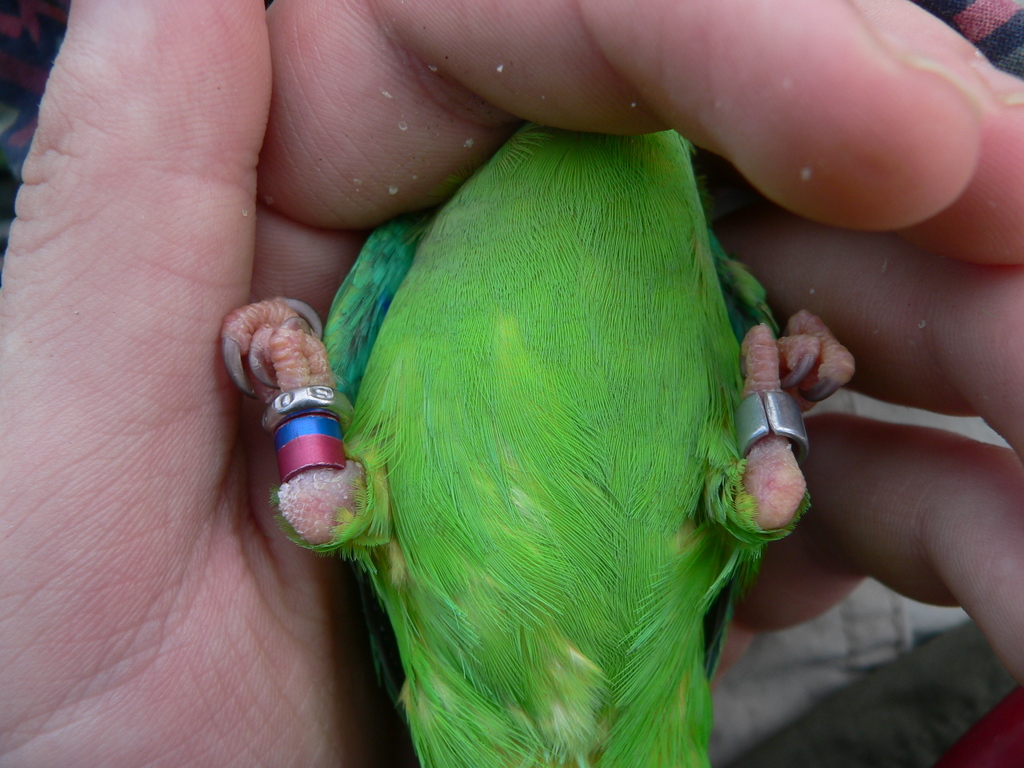
A parrotlet receives shiny new bands
Watching these parrots on the fences at close range is a study in the color green – one wonders why an all-green parrot would be given the name Green-rumped Parrotlet, and the rather plain illustration of a single individual in Hilty’s Birds of Venezuela does not really answer. In life, these mini parrots flash bright lime green rumps that contrast starkly with olive-green back and wings and plain green to yellowish-green underparts. The gender differences are also more apparent than the guide lets on – the female’s face is yellow-green fading to yellow on the forehead. The male has a rich green facemask set off by a gray-green wash across the nape and neck. The facemask can be puffed out, obscuring the bill like feathery jowls. Finally, in a splash of extravagance in all this green, the male has blue and navy patches on the wing that he flashes in displays and aggression.
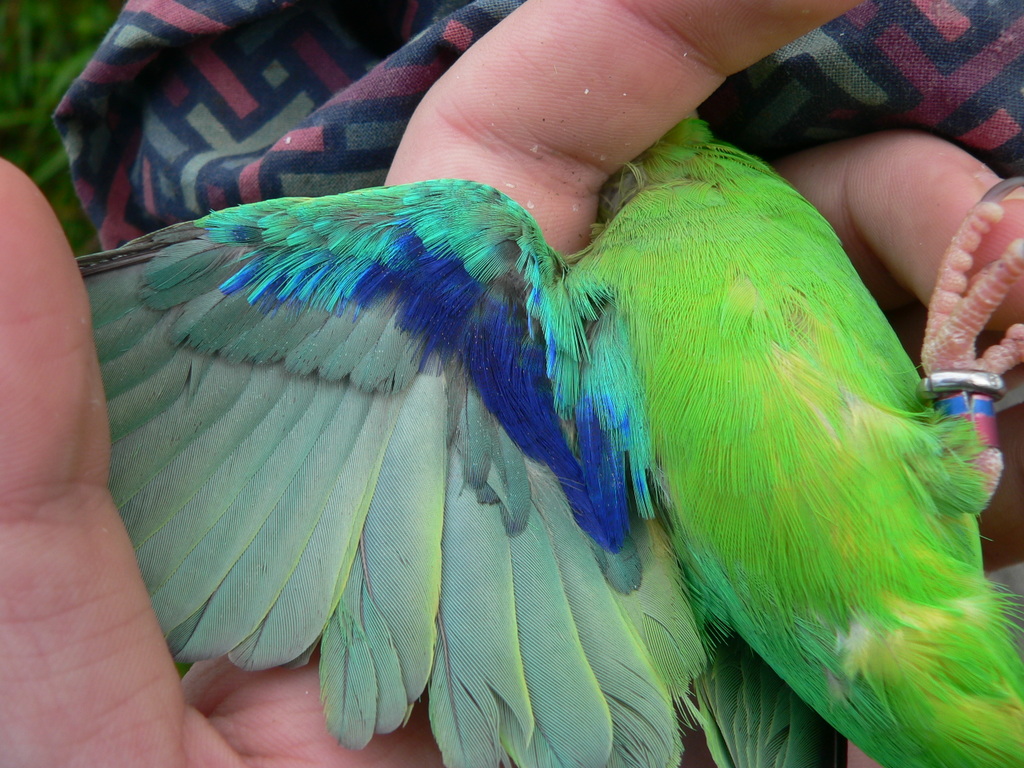
A male parrotlet´s flash of color
The harsh CHEter CHEter CHEter of a displaying pair of White-bearded Flycatchers (Phelpsia inornata – a llanos endemic species and genus) distracts me from Forpus-watching and spurs me back into work mode. After getting the combos on the pair at B17, then I walk down the fence, opening the top of each box and shining my maglight down to the bottom to look for eggs. The parrotlets don’t appreciate this and take off chattering. B42 and B17 are empty, but in B41 I find a single egg. I open up the bottom of the box and slide out the wire nest chamber, marking the egg with the number 1 and weighing it – 2.5g. All of the eggs of each nest will eventually be numbered by lay date and weighed. Since I saw both pairs fighting over this box, I will have to return later to find out which of the two pairs at Tomas Fence actually own this egg, and which pair are the aggressors looking to obtain a nesting site by force. I check about 30 more boxes in the increasingly oppressive sun, finding two more new nest attempts with a new egg each. Eventually their clutches will swell to as many as 9 eggs, but for now there aren´t many to measure. Finishing the nest checks for the day, I retire quickly from the field for lunch and siesta.

A Forpus nest with a full clutch of eggs
The ornithologist’s house looks just like all the other ranch buildings in the grove of trees – a cement block building with corrugated metal roofing. Burning under the midday sun, you can turn your face up to the roof overhead and be bathed in the heat radiating downward. When the frequent power outages knock out our fans, it is positively stagnant inside. There are only three ornithologists here among the llaneros (cowboys) – myself, Karl, and Elysa, a Venezuelan field assistant. I’m sure our lunches sound very strange. Our conversations flow from English to Spanish (it takes every bit of my concentration to keep up when Karl and Elysa converse – estoy aprendido) but frequently it sounds like we’re gossiping about the neighbors. –Oh, I saw so-and-so together today. –Really! What were they doing? –Allopreening and kissing!
Courtship behaviors are easily observed this time of year, and as I saw this morning a whole new crop of nests are being started. The parrotlet nesting season at Masaguaral has two peaks – one from June through August, coinciding with the start of the rainy season and a proliferation of food. The second wave begins in September, when pairs can shake off their first brood of fledglings to renest. Many new pairs also begin nesting. I arrived just in time to see the last breeders in the first wave fledge, and to start anew with the second wave.
Most of the biology of Green-rumped Parrotlets is known from the ongoing work here at Masaguaral, now in its twentieth year. In 1988 Steve Beissinger, a professor at Berkeley, started the Forpus project with a mere forty boxes. Since then the project has evolved into a massive dataset – Karl tells me these parrotlets are probably the most well-studied neotropical bird and the best-known parrot species. We keep track of every bit of data we can – identities, parentage, behaviors, egg-laying and hatchling days and weights, fledge dates, and more recent projects include analysis of vocalizations and displays (Karl’s work). From this mountain of data Steve and collaborators have generated a good pile of publications, ranging from hatching asynchrony and clutch size to sex ratio, metabolism, population dynamics, and behavior, including a lengthy work summarizing of the breeding behaviors of the parrotlets (Waltman and Beissinger 1992 – worth a read).
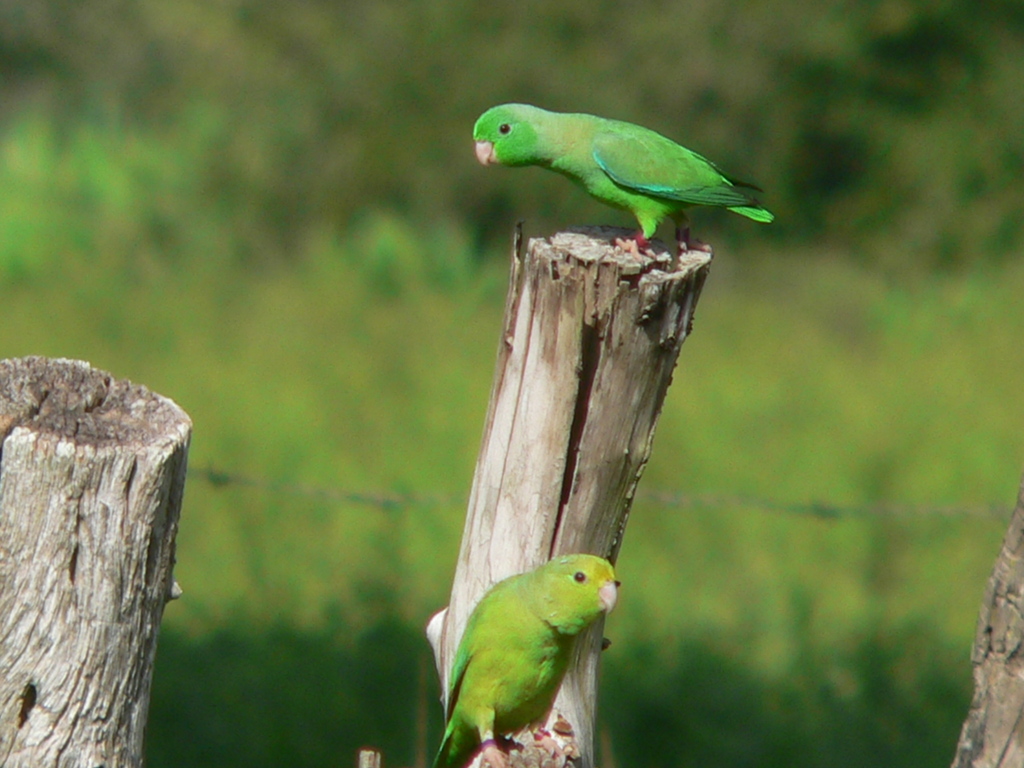
A pair of Forpus – note the color differences
The Waltman and Beissinger paper perfectly describes the confusion this morning at Tomas Fence – “While prospecting at nest sites, pairs were often accompanied by and fought with additional pairs and unmated males. Birds gave a threat display by spreading wings, expanding plumage, and crouching with bills open and tails fanned.” Most nest prospecting I’ve seen so far hasn’t been so exciting. Normally a pair investigating a box will sit together at it. The female sits on the front perch, peering down into the box but frequently jerking back out of the hole to look around nervously. The male stands guard, but also takes turns peering into the box. Eventually they parrotlets get comfortable enough to enter the box completely. Hopefully a nest attempt follows soon after.
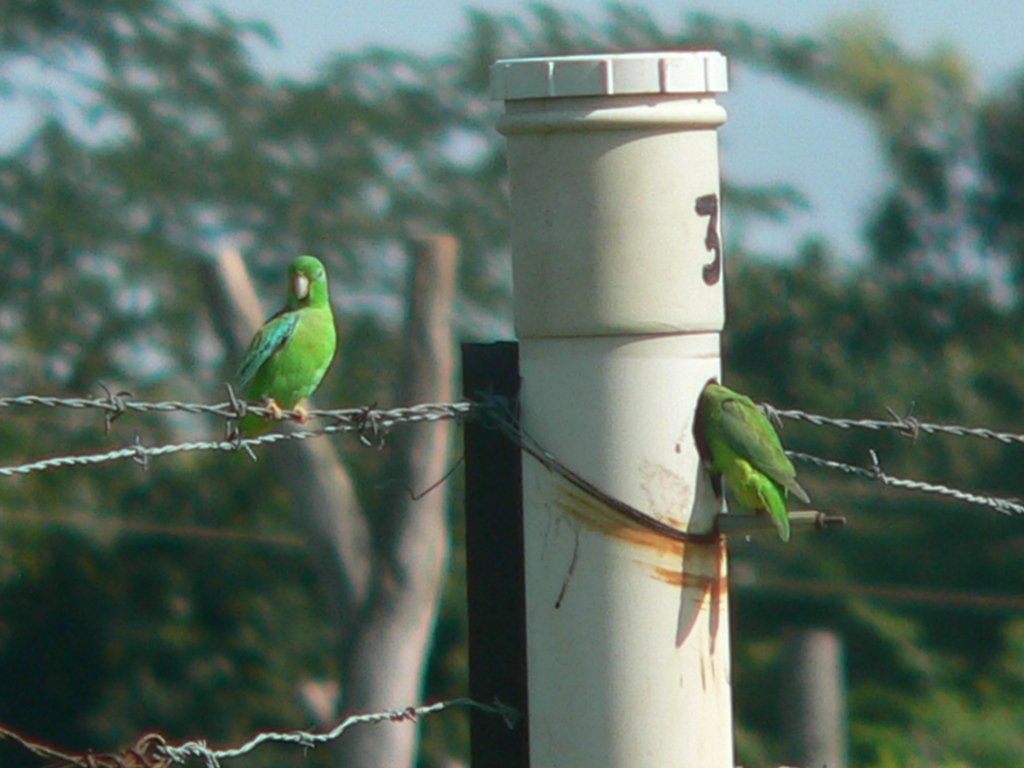
A pair of parrotlets prospecting a nest box
Parrotlets form strong pair-bonds that can last years, and fooling around (also known as extra-pair paternity) is very rare. We identify birds as mated pairs by the courtship behaviors observed. We look for several types of behaviors, described in the Waltman and Beissinger paper – wing-flashing, allopreening, allofeeding, French-kissing, and copulations. Wing-flashing is performed by the males who flick or lift their wings to show off their pretty blue color patches. This behavior has several variations, the precise roles of which are not entirely clear. Allopreening has got to be one of the cutest behaviors exhibited by any bird. The pair fluffs up together and preen each other. While cuddling one will lean into the other and let them preen all around the head in those hard-to-reach spots. Allofeeding is a necessary but important business. The male parrotlet assumes the duty of feeding the female during egg-laying and incubation, and it is his job to get her weight up high enough to sustain her. He does this by eating a whole bunch of seeds to bring back for his girl. He then clasps bills with the female and barfs the seeds down into her mouth. It’s an amusing and messy affair, with both individuals ending up with seed-mush-smeared faces. Following allofeeding and allopreening the pair often engages in French-kissing bouts, clasping bills but without the mess of allofeeding. Finally, copulations are unique in parrotlets for their length. The male at B42 was recently seen copulating with his girl for two minutes and thirty-five seconds. Compared with most other birds, that is an eternity.
As the afternoon wears on, I have to put down all this fascinating parrotlet literature and actually get back in the field. I grab a scope and head out to the huge front pastures to Big Bend Fence to resight a pair that just started a new nest. I sit out in the open field for two hours as the sun sinks down, but I don’t see the pair at B33. At nearby B32, the last two nestlings of the first nesting phase crowd the entrance of their box, on the verge of fledging. I can here their older clutch-mates flying around harassing their parents nearby. When these two fly, we will be back to just eggs in all of the nest boxes, and a three week wait before we see any more nestlings.
A sudden piercing screeching call comes from a nearby tree in the pasture. A parrotlet rounds the tree with two Aplomado Falcons in hot pursuit. The parrot dives into the thickest tangles of the tree and disappears. The falcons dive into the tree after it. I whirl my scope around and find the two falcons perched in the upper branches of the tree. I didn’t see the parrotlet leave the tree, but the falcons were not clutching any green mass in their talons, so I assume he escaped this time.
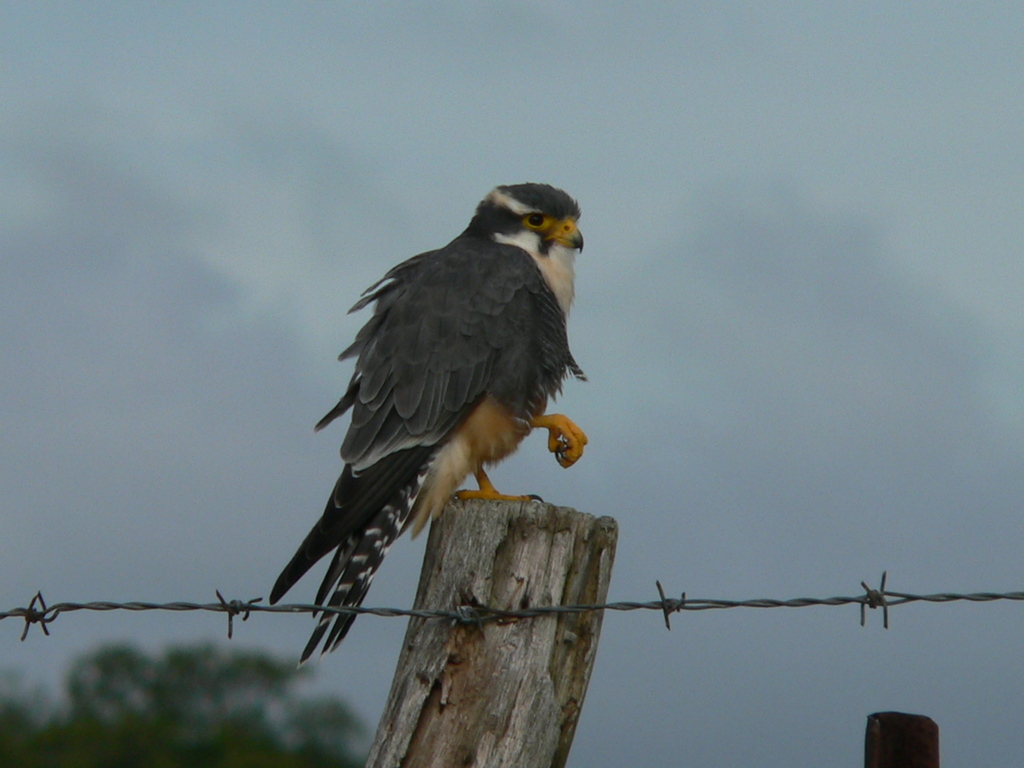
Aplomado Falcon (Falco femoralis) – mortal enemy of parrotlets
I don´t know if it was falcons or some other cause, but I never saw the pair at B33 again. Their one egg was left abandoned after a brief failed nesting attempt. I never got their bands, so this goes down as an unknown nest attempt. We can´t get them all, but we try our best.
My efforts keep me out on the front pastures until sunset. Our evenings are full of dinner and data entry, but the sunset over the pastures is always worth sticking around just a little bit longer.
Reference
Waltman JR, Beissinger SR (1992) Breeding behavior of the Green-rumped Parrotlet. Wilson Bulletin 104(1):65-84 (Available via SORA)


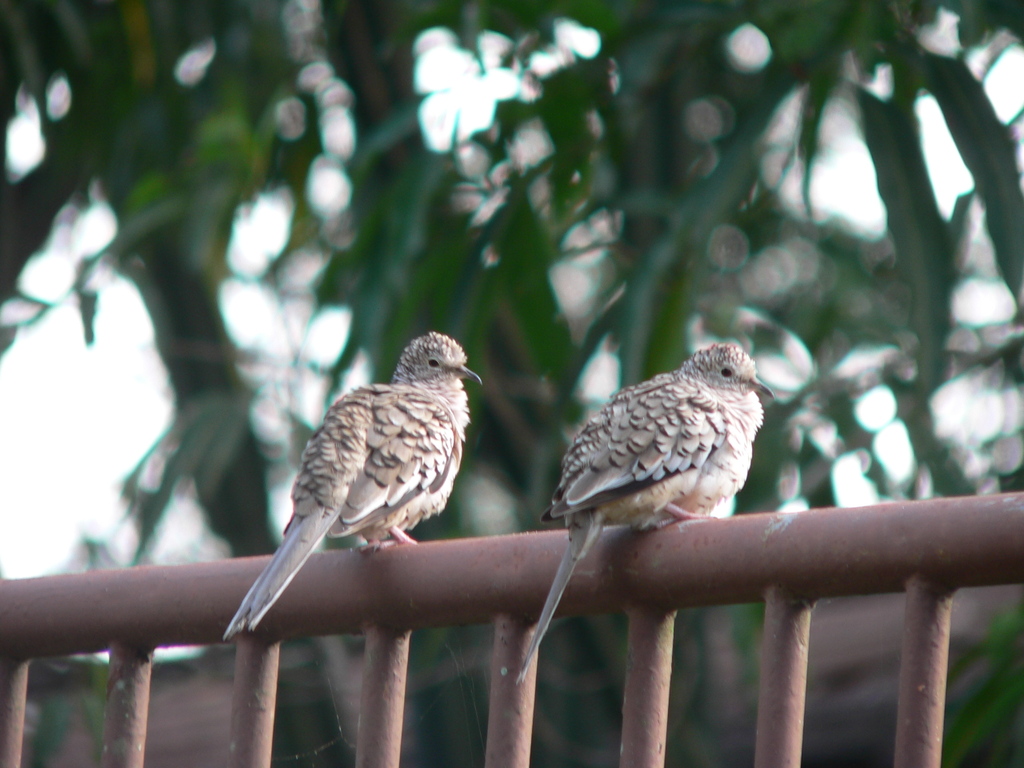
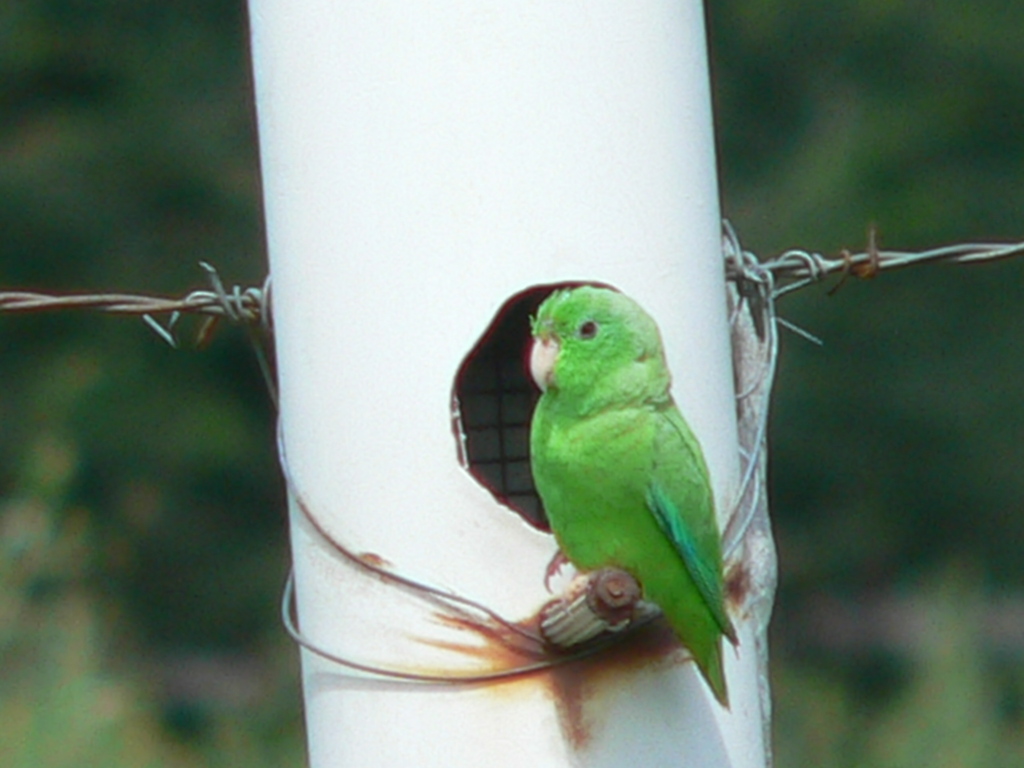












Looks good!
Great stuff Nick. Looks like you’re having fun.
Nick, never understood why this didn’t get more comments – really good writing and info on a bird most of us have probably never even heard of…
Don’t worry none about it Charlie. I like to think I just stunned them into submission. If this one didn’t, my latest post will! It’d probably receive an R rating. 🙂
Fascinating article ~ thank you so much for sharing it with us armchair biologist wannabes.
Any chance of your trekking into the Peruvian forests and searching the canopy for lineolated parakeets?
Lynne
Thanks! Not much chance of me getting to Peru although I would love to do so in the next year or two. Got money to pay for a field assistant? 🙂
Congratulations, is excellent research , I’m glad somebody shows interest in this species…
My pet green-rumped female died a few months ago at age 14. I miss her a lot and it is great to see pictures of them out in the wild. She was always very feisty and had tons of personality. I contacted Steve Beissinger a couple years ago to try to learn more about these birds in the wild and he said that females are known for their agression towards other birds. It must be wonderful to see them in the wild. I hope my little Kiwi is flying free in her birdy heaven and has a cute male around to cuddle with.
This was a fantastic and hugely informative article. I just got my first pair of Pacific’s and feel this gives me a little more insight of what I have to look forward to!
Thanks! and would love to hear more!
Very informative, especially the photos. I was reading Virginia Morrell’s account of her visit there and was thrilled to find this colorful posting on my first look. I look forward to learning the results of this research.
I worked on this project in 2001, I wish I had taken photos, but I didn’t so seeing your is quite a treat! Thanks!
this is an amazing write up / experience I’m truely envious of you. I would love to watch these beautiful birds in their natural habitat. I have two pairs and I just love theme so much wonderful little parrots. Great photographs too. X